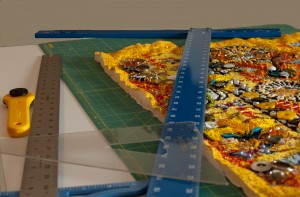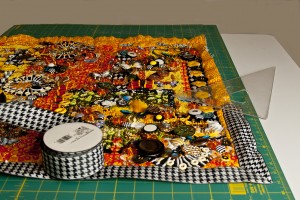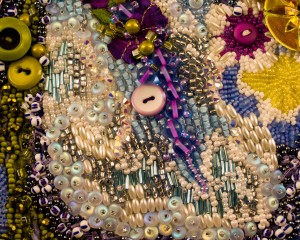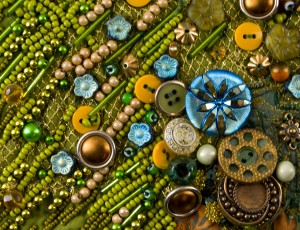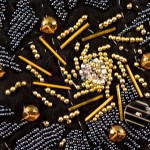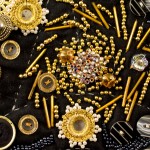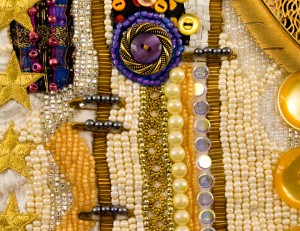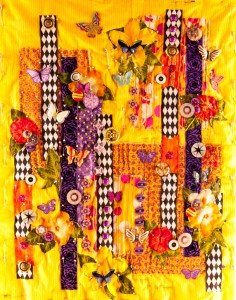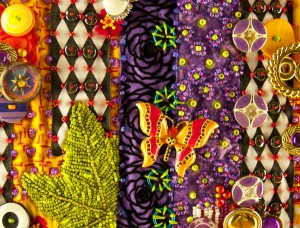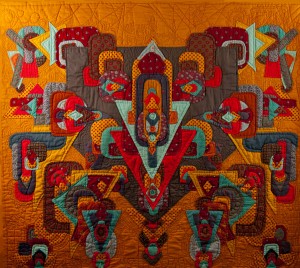 After having taken a workshop with Nancy Crow in the early 80s, and receiving encouragement from her to keep on with my geometric series, I began with this quilt, “Opulence- Warm Slate”. I had no idea at the time what my later work would look like, and how embellished it would end up, but for me, I thought that the quilts in the series were pretty opulent, given the number of pieces that were hand appliqued in place. I also love contradictions in word phrases. The blue- grey slate color somehow was a given, but it ended up on a warm pumpkin orange background. If you’ve ever touched a piece of slate rock, it is anything but warm,as it tends to release heat pretty quickly, hence, for me. a quirky title for this piece was born.
After having taken a workshop with Nancy Crow in the early 80s, and receiving encouragement from her to keep on with my geometric series, I began with this quilt, “Opulence- Warm Slate”. I had no idea at the time what my later work would look like, and how embellished it would end up, but for me, I thought that the quilts in the series were pretty opulent, given the number of pieces that were hand appliqued in place. I also love contradictions in word phrases. The blue- grey slate color somehow was a given, but it ended up on a warm pumpkin orange background. If you’ve ever touched a piece of slate rock, it is anything but warm,as it tends to release heat pretty quickly, hence, for me. a quirky title for this piece was born.
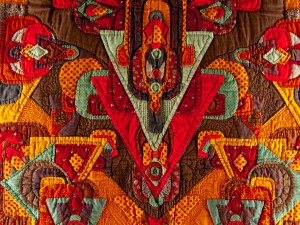 This detail shot of the center of the piece shows some of the intricate hand applique and hand quilting that went into this piece. Measuring 41″ W x 37.25″T (104 cm W x 94.5 cm T), I had lots of room to create a symmetrical arrangement that still had lots of room for intricate additions. When I was doing this geometric series, I had a hardware tackle box filled with different sizes of shapes that I had cut out of clear acetate. I had these templates at the ready, and so when I could “see” that a certain area needed a circle, I could go through my collection to see what size I needed. Having clear templates also made it easy to position the plastic exactly over what part of the fabric that I wanted to cut out. I’d put the template into place, trace around it with a white or yellow colored pencil (depending on the color of the fabric, and then when I cut it out, I added an extra 1/4′ ( 7mm) of fabric for turning under when I sewed. So, if I wanted a rose to be in the center of a particular motif, I could see where to place the template for the cutting.
This detail shot of the center of the piece shows some of the intricate hand applique and hand quilting that went into this piece. Measuring 41″ W x 37.25″T (104 cm W x 94.5 cm T), I had lots of room to create a symmetrical arrangement that still had lots of room for intricate additions. When I was doing this geometric series, I had a hardware tackle box filled with different sizes of shapes that I had cut out of clear acetate. I had these templates at the ready, and so when I could “see” that a certain area needed a circle, I could go through my collection to see what size I needed. Having clear templates also made it easy to position the plastic exactly over what part of the fabric that I wanted to cut out. I’d put the template into place, trace around it with a white or yellow colored pencil (depending on the color of the fabric, and then when I cut it out, I added an extra 1/4′ ( 7mm) of fabric for turning under when I sewed. So, if I wanted a rose to be in the center of a particular motif, I could see where to place the template for the cutting.
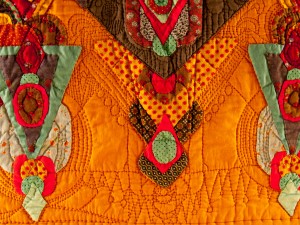 The hand quilting that I spent hours on shows up in this detail shot. I used a contrasting thread, in this case, a dark orange red, because if I was going to do all of those little tiny stitches, I wanted them to show. I did use a quilting frame for a piece this large, but since when I bought it, I had no idea the size quilts I would be making, I purchased one with 6′ (2m) poles on to which to roll the quilt sandwich as the work progressed. Since I liked to watch TV as I quilted at night after teaching school all day, that frame took up quite a bit of room in the family room. (Another source of “discussions” with my ex!) I drew some of the quilting lines lightly in place with a pencil, but as the work progressed, would often have to go back and redraw the lines, as they would get rubbed off as my hands and arms moved across the surface. I was using some “echo quilting” in this piece, where lines are stitched parallel or repeat around and round lines already stitched. It’s often used in Hawaiian quilting, where the quilting lines ripple outwards as if a pebble had been dropped in a pond.
The hand quilting that I spent hours on shows up in this detail shot. I used a contrasting thread, in this case, a dark orange red, because if I was going to do all of those little tiny stitches, I wanted them to show. I did use a quilting frame for a piece this large, but since when I bought it, I had no idea the size quilts I would be making, I purchased one with 6′ (2m) poles on to which to roll the quilt sandwich as the work progressed. Since I liked to watch TV as I quilted at night after teaching school all day, that frame took up quite a bit of room in the family room. (Another source of “discussions” with my ex!) I drew some of the quilting lines lightly in place with a pencil, but as the work progressed, would often have to go back and redraw the lines, as they would get rubbed off as my hands and arms moved across the surface. I was using some “echo quilting” in this piece, where lines are stitched parallel or repeat around and round lines already stitched. It’s often used in Hawaiian quilting, where the quilting lines ripple outwards as if a pebble had been dropped in a pond.
The colors in this quilt pleased me, so it hung in my house for quite awhile. However, vertical wall space became a premium as the years went by, as I’ve lived in this house for over 30 years. As more and more quilts were created, this piece went into storage to await a retrospective of my work some day. However, I guess that this blog is a virtual exhibit of what I’ve done and where I’ve been in the wide world of art quilting.
How do you decide on the names and images for your quilts? Are you into quickly achieving a finished product or are you a “Fan of the Long Sew?”
Why not leave a comment as to your thoughts on this posting. Please take a minute, fill out the form below or by clicking on the “comments/no comments link” at the top of the posting, and then share your ideas with the rest of us. We all grow when we share our thoughts and impressions, so why not join our growing community of those who appreciate art quilts and textile arts. We’d love to hear from you!… and PLEASE tell like minded souls about this blog! The more readers and contributors, the more I write.
You can see more of my art work on my web site at www.fiberfantasies.com (be patient as it loads; it’s worth it), my healing work at www.hearthealing.net and can find me on Google + , Facebook (for Transition Portals) Facebook (for Fiber Fantasies), and Twitter.
To find out how to buy my art work, please check out “How to Buy my Art Work” in the “Pages” section to the right of this blog.


